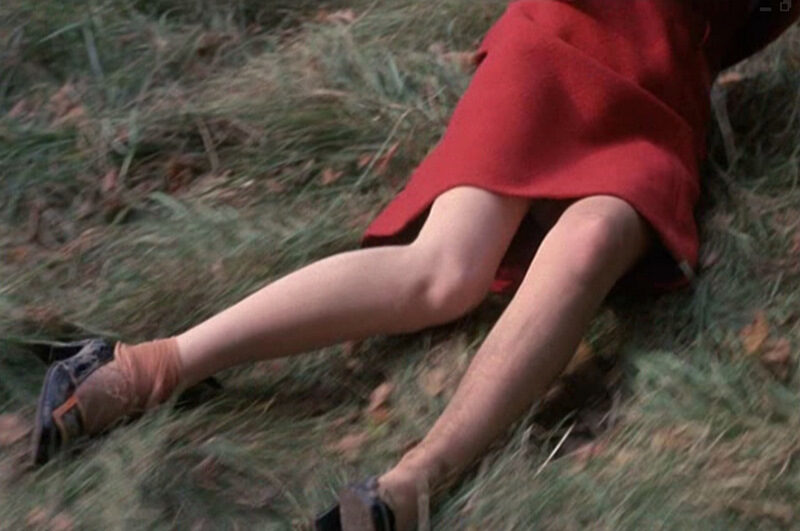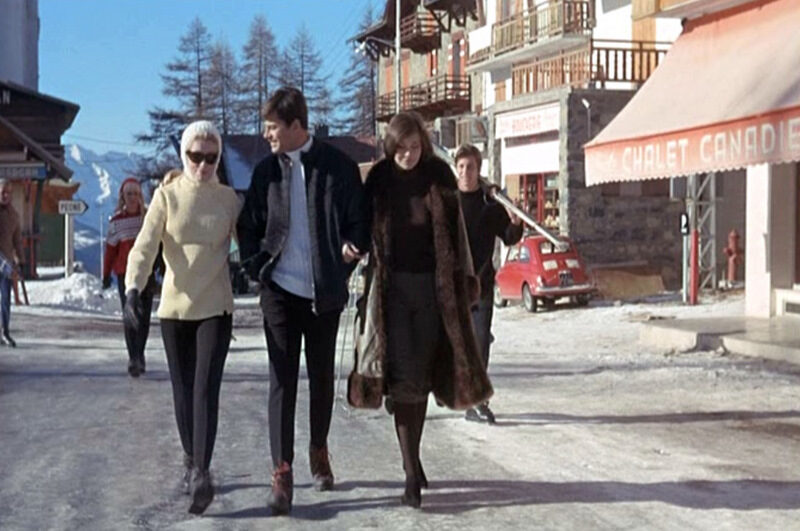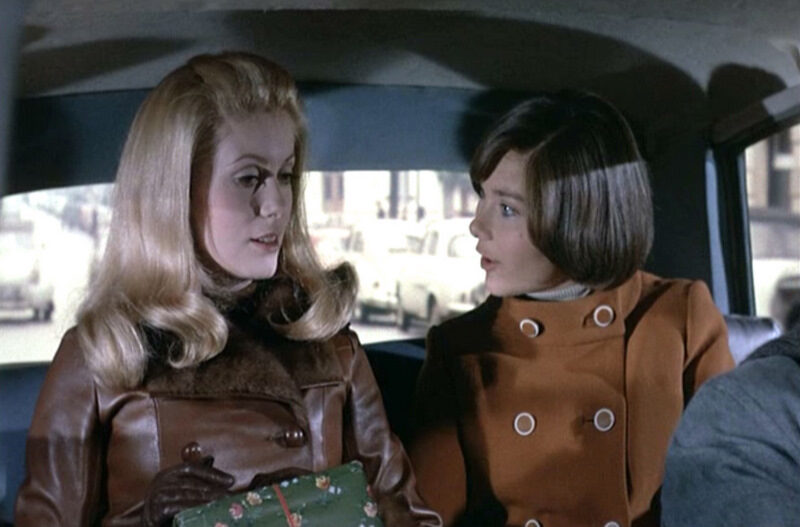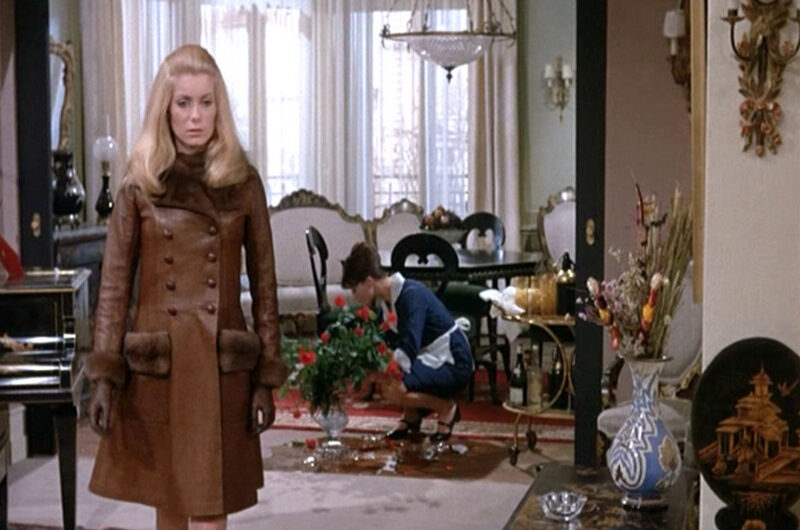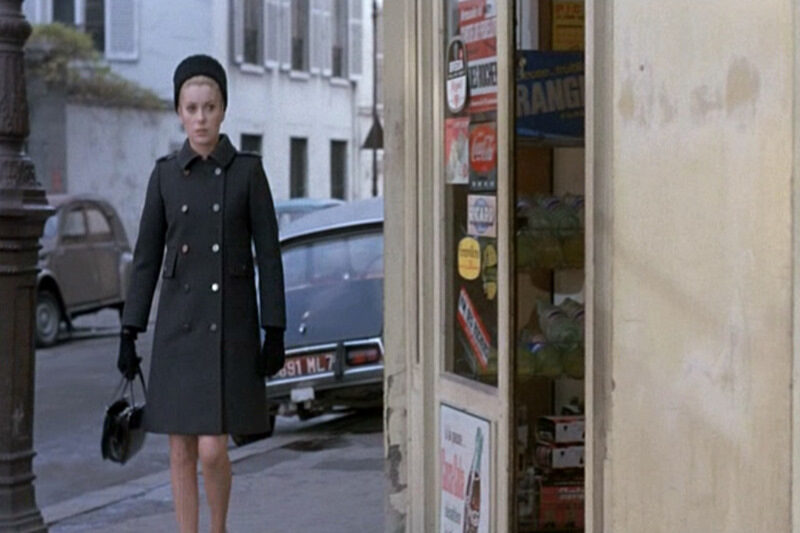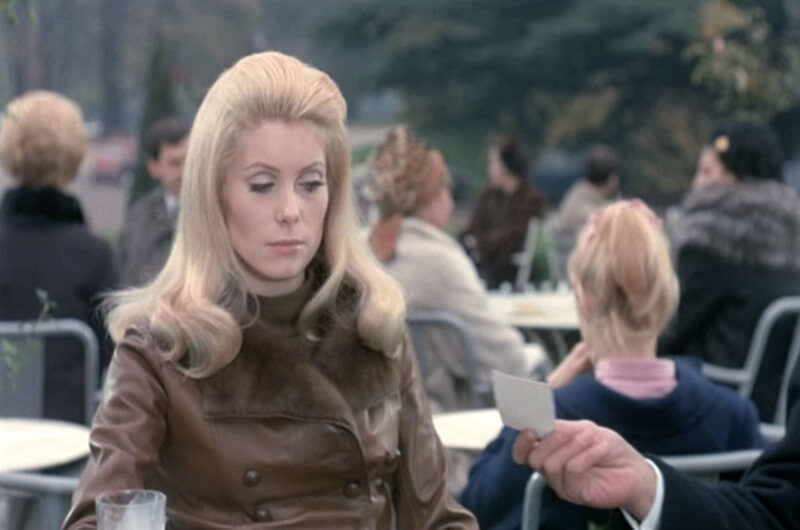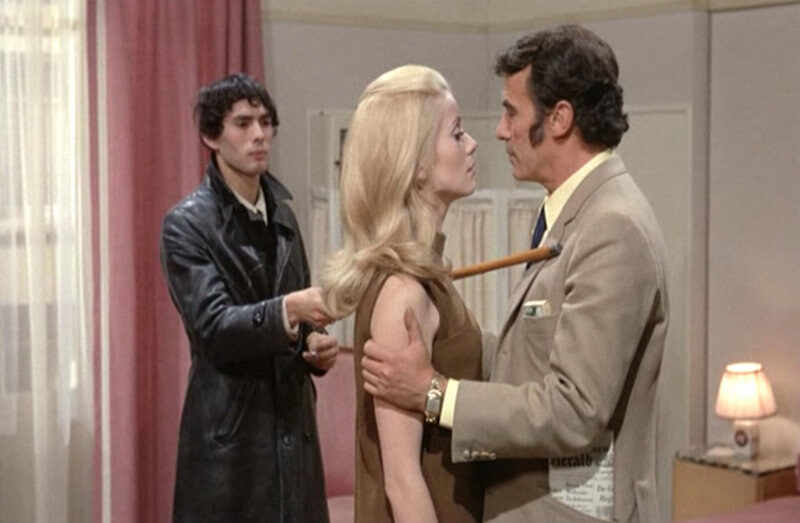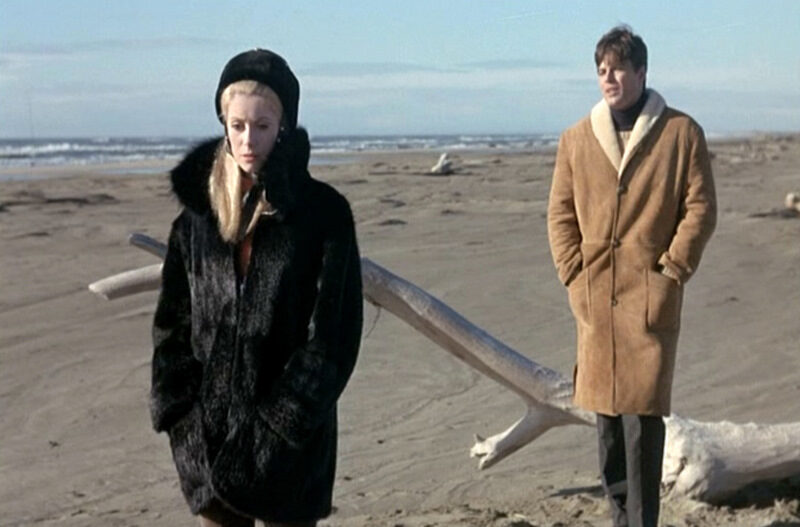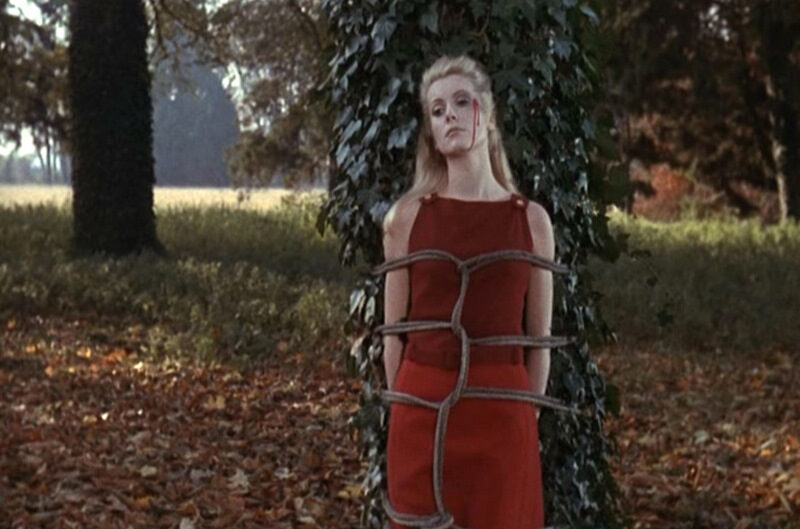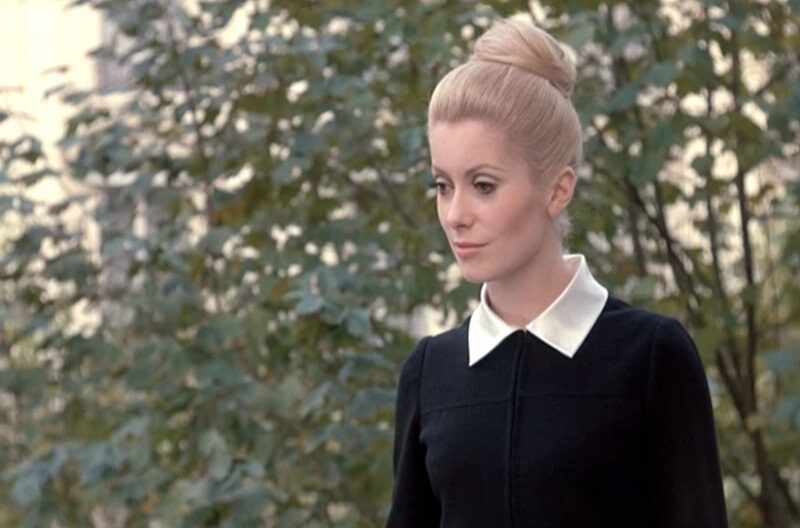Belle de Jour: Sex and Alienation | Clothes on Film
Featuring couture as cool and disaffecting its protagonist, Belle de Jour (1967, directed by Luis Buñuel) has much to say through its ambiguous antiplot narrative and can be read effectively through costume.
Catherine Deneuve plays Séverine, a bourgeois housewife unable to commit sexually to her husband Pierre (Jean Sorel). Instead she fulfils her sadomasochistic fantasies by becoming prostitute ‘Belle de jour’ at an intimately run brothel.
Every afternoon between two and five Séverine services clients of various persuasions as her eyes are gradually opened to the possibility of sexual satisfaction. Yet the deeper she digs the more her bourgeois existence is threatened. Eventually Séverine quits the brothel and returns to her routine life. However prompted by Pierre discovering the truth of her double life the sadomasochistic fantasies soon return, more intrusive and vivid than ever.
Séverine disassociates sex the same way she dissociates herself. With her withdrawn demeanour and starkly beautiful clothes (Catherine Deneuve’s costumes were designed by Yves Saint Laurent, with overall costume design attributed to Hélène Nourry) she does not equate sex with happiness, but pleasure. This is why Séverine cannot contemplate sex with her husband. She is guilty for desiring her fantasies; remove the guilt and she no longer derives pleasure.
The first outfit we see on Séverine is a crucial one. It is worn during the film’s very first scene, a daydream whereby Séverine is dragged from a horse drawn carriage by two coachmen on Pierre’s orders, tied to a tree and whipped with a cat o’ nine tails (“Don’t let the cats loose!”). Her petrified screams intermingle with moans of pleasure as the violent fantasy culminates:
Short red ‘Eisenhower’ style jacket, double breasted with ten buttons. Two tone red mid-length princess line dress with button shoulder straps and thin red belt. Black patent leather ‘Pilgrim’ court shoes with thick high heel and decorative gold buckle by Roger Viver.
Similar to the work of Pierre Cardin and André Courrèges at this time, Yves Saint Laurent championed precise cuts and a clean finish. This muddy red dress was reminiscent of Saint Laurent’s output from at least the previous year. Though by his normally minimalist standards, the thin belt and shoulder buttons are actually quite decorative.
The dramatic colour of her jacket establishes Séverine as a depraved ‘scarlet woman’. A lingering shot of her shoes signifies displacement; Séverine is a fetish for the viewer. Velcro was used to fasten Deneuve into the dress so a ‘ripping’ sound could be heard as the seams were split. Saint Laurent evidently worked well with Buñuel, understanding that garments must be adapted to serve a director’s creative requirements.
Séverine drifts back to reality in the bedroom of her and Pierre’s Paris apartment. Subsequent to a conversation in which she only reveals scant details of her dream to Pierre, the film then shifts location to an upmarket ski resort. Here, again, Séverine’s outfit is noticeably unfussy:
Cream sweater with asymmetrical zip front, round neck and sleeves that stop just short of the wrist. Slim black ski-pants. Black leather gloves and white balaclava.
Though perfectly suitable to the cold environment, Séverine changes her cream pullover for a pale yellow cable knit with button fastening for the subsequent scene at a restaurant (this could have been under the sweater, but scantest amount of white cuff poking out tends to suggest otherwise).
Apart from signaling the passage of time, there is no narrative need for this change unless to draw attention to Séverine’s ‘buttoned up’ persona around well-mannered Pierre’s polar opposite friend Henri (Michel Piccoli), a man in whose presence Séverine clearly feels uncomfortable. As she enters the restaurant, Séverine tosses a stuffed toy animal to a Maître d’, a discreet nod to her soon to be discarded innocence.
Back in Paris, Séverine takes a taxi ride with Henri’s partner Renée (Macha Méril). Here Renée informs her of the bourgeois frequenting brothels, not just as male clients, but as the female prostitutes servicing them. Dreamily glazing over, the idea titillates Séverine despite herself.
Méril wears an orangey brown funnel neck wool coat similar to Audrey Hepburn’s (costumed by Givenchy) in Breakfast at Tiffany’s (1961). Deneuve is more suggestively attired in fur trimmed leather:
Dark brown double breasted leather coat, fur lined, mid-length princess-line cut, leather buttons, rear vent and half belt. Brown leather gloves and medium tote bag. Raw Umber brown sleeveless shift dress, princess line, with polo neckline, high yoke and armholes.
The abundance of buttons on the coat, most of which are decorative, i.e. symbolic, denote Séverine’s deliberate repression, although this time contrasted with the erotic appeal of shiny leather. Inside her apartment we get a better look at the sumptuousness of the coat plus a fleeting glimpse of Séverine’s slightly flared shift dress as it hangs off her vulnerable body.
For a final (missed) opportunity to let Pierre in on her fantasies, Séverine wears an unmistakably ‘girly’ pink robe over a plain white nightdress. From the impureness of her thoughts we move to a scene at the tennis courts where Séverine is dressed whiter than white in tennis skirt, polo-shirt, headband and fluffy jumper. However, as pure as she appears, the facade is crumbling. Séverine is anxious around Henri yet entranced by his unrestricted sexuality.
Following this scene is Séverine’s first visit to the brothel. She only makes it to the outside door at first but returns twice later in the day wearing the same outfit. It is the most austere of chic couture:
Grey wool double breasted mid-length coat, ventless with horizontal seam, wide-set collar, epaulettes, sleeves finishing just below the wrist. Black high crown brimless hat in ribbed wool, black leather gloves, black frame handbag, brown tortoiseshell wraparound sunglasses, black Roger Vivier shoes with gold buckle.
Fastened to the neck, but with a loose button on the shoulder (as remarked upon by Madame Anais), this coat marks Séverine’s dark decent into sexual depravity. Donning sunglasses for her next visit to the brothel, Séverine hides behind darkened lenses until the last possible moment of committal. Inside for the third time she removes her coat to reveal a khaki colour safari style shirt-dress that exemplifies Yves Saint Laurent’s mid to late sixties style direction:
Khaki shirt-dress, fly-front with zip to natural waist, high yoke, epaulettes, shirt cuffs, two patch pockets to the hip and thin gold chain belt.
In 1966, Saint Laurent launched Rive Gauche ready-to-wear with unisex safari suits, the patch pockets and belted styling similar to this dress in Belle de Jour. Virtually all of Séverine’s clothes are military inspired, referring to the regimented way in which she lives her life as a bourgeois. Most interesting of all is how such a plain dress can look so exceptional. Bland colours and simple shapes work only to intensify the beauty of a beautiful woman. These women are attractive to the spectator because one assumes they do not have to try. Self-confidence is ingrained.
After her first client, Séverine waits a short while before going back. In-between she has another fantasy, this time against a cattle drive backdrop. Tied to a post in a flowing white dress, Séverine is pelted with mud by Henri. The expression on her face throughout is one of ecstasy; she is enjoying the degradation.
Arriving unexpected at the brothel, Séverine chooses a characteristically fetishistic material, PVC, as if pledging to Madame Anais her seriousness to continue as a prostitute:
Black PVC tunic style coat, mid-length, ribbed wool sleeves with thin tie belt. Khaki shirt-dress. Black ribbed wool hat.
The same khaki dress is worn underneath, the girls in the brothel again fawning over it with almost sensual delight; the ease of the dress zip signifying Séverine’s rush to reach fulfilment.
Her next major outfit change occurs at the open-air restaurant. There is contention as to whether this scene actually happens or is instead another of Séverine’s fantasies (even Buñuel and Belle de Jour screenwriter Jean-Claude Carrière cannot agree). The carriage, the familiar coachmen, the dissociated location – these all suggest the latter. But interpretation is actually irrelevant. What Buñuel is trying to say is that there is no need to disconnect fantasy and reality at all.
Here Séverine again wears the brown leather coat with the same brown polo-neck shift dress underneath. For the necrophilia ritual at the Duke’s stately home she is required to strip naked and don a role-play costume, a black sheer cloak with small white flowers on the headdress. Séverine then climbs into an open coffin while the Duke masturbates over her (figuratively) as the deceased body of his daughter.
Barely clothed in shift dress and shoes, she is then hastily ejected from the premises. Masturbation is customarily aligned with feelings of guilt after the act. At this stage – even more so with the incestuous undercurrent – Séverine finds herself cast aside as an intruder.
Several clothing changes now occur in relatively quick succession. First a floor-length pink flower print negligee trimmed with flowers along the neckline that Séverine wears to initiate a cuddle in bed with Pierre, though still no sex (paralleling an earlier quasi-inmate scene with the couple). The brown shift dress appears once more as Séverine hides from Henri inside her apartment. Evidently she can snub Henri in real life but cannot exorcise him from her dreams; he features in an ensuing fantasy performing some unseen bizarre sexual act with her under a restaurant table at the ski resort.
For her introduction to enigmatic Marcel (Pierre Clémenti) at the brothel, Séverine again wears the brown polo neck shift. During this pivotal moment Clémenti’s beatnik costume is stressed more than Deneuve’s plain and, by repetition, now unremarkable dress. His long black leather boots are fetishised by Séverine as she joins the role of spectator, aligning her sight with ours.
After a passionate sexual encounter with Marcel we cut to Séverine and Pierre on holiday at the beach. She wears an entirely new ensemble. Sitting on a rock in what looks to be the middle of nowhere, Séverine’s outfit denotes both a practical choice for the blustery location and subtle hint at her desire to be elsewhere:
Dark brown fur coat with high upturned collar, zip front. Light brown slim leg trousers. Dark brown leather rimless hat with thick fur trim, chin straps tied as a bow; brass studs to the crown and straps. Black leather slip-on shoes.
Séverine still longs to be at the brothel, or more specifically with Marcel; the confining appeal of studs and leather divergent with the open-air freedom around her.
For Séverine’s second meeting with Marcel she revisits the scarlet woman in her short red military jacket and two-tone red shift dress. Her Roger Viver shoes are lingered over as an ongoing symbol of change. First at the start of the story representing Séverine’s need to transpose dream with real life, second when she reaches a point of no return by knocking on the brothel door and now, entwined with Marcel, at the moment she falls in love. A close-up of Marcel’s holey sock draws attention to the socio-economic divide between them, an unexplored point up until now.
Séverine seems upbeat in Pierre’s company as they stroll outside his place of work. Though Pierre is distracted by the foreboding wheelchair oddly abandoned at the entrance to the hospital, Séverine remains untroubled. She is happy again.
Hinted at in the previous brothel scenes is Séverine’s increasingly sloppy appearance. Only half-dressed in white dressing gown and slippers and her hair a mess, she is discovered working as a prostitute by Henri; he immediately rejects Séverine for losing the one thing that made her attractive to him – her pureness. It is ironic too that the only patron to know Séverine as the immaculate and controlled person she really is happens to find her at this slovenly ebb.
Séverine’s shame at being found out prompts her next fantasy, with Pierre and Henri dressed in Victorian top hat and frock coat fighting a pistol duel, we presume over her. This culminates in Pierre shooting Henri off-screen then rescuing Séverine tied to a tree, her face bleeding from a wound. They kiss passionately, more so than we have ever seen before, and the narrative cuts back to reality.
Making a decision to leave the brothel for good, Séverine departs exactly as she had arrived, buttoned up in the austere grey coat. It is as though nothing has actually happened, like the bookending of a dream.
From here the story sets up its climax. Wearing the unstructured brown shift dress from much earlier, Séverine sits in her apartment coveting a new pair of shoes. Transferring desire onto a common fetish, this patently readable scene offers Séverine a knowing moment of recognition. Marcel then unexpectedly visits, but she rejects him to in favour of her life as a bourgeois. Events soon spiral out of control as Marcel waits outside the building and shoots Pierre on his return.
At the hospital, accompanied by studiously attired Renée, Séverine looks inappropriately sluttish in her wet-finish PVC coat; implying her wayward actions alone are responsible for Pierre’s life threatening condition.
As if to acknowledge this guilt her final outfit Séverine wears is almost comically prim:
Black mid-length shirt-dress with white silk contrast stand collar and French cuffs, high yoke, zip front, black belt. Black suede court shoes with arched top line.
When Henri arrives to visit Pierre he remarks upon Séverine’s schoolgirl-like ensemble. She descends further into submissiveness when he proposes to tell Pierre of her life as a prostitute. We do not see Henri’s confession, but Séverine lurks outside the closed door like a pupil summoned to see the headmaster. On finally approaching him we see the shoes again (a transition time), her hand forced along a nearby table slowing the inevitable.
With Pierre knowing the truth Séverine’s world is no longer her own. She escapes into a fantasy, one that is so vivid as to encroach directly outside their home. It is doubtful Séverine will ever abandon this form of release (especially with Pierre being paralysed, seemingly from the waist down, so sex with him is as inconceivable as ever). She will either accept the fantasies for what they are: escapes from reality to remain unconsummated and return to her ‘normal’ life, or be driven mad by their unfulfilled promise.
Belle de Jour would be a pro-feminist film were it not for the flashbacks indicating Séverine’s sexual abuse as a child. Without these scenes she is merely a woman gratifying her sadomasochistic desires, yet now her behaviour can be termed as ‘deviant’. She does not enjoy her desires so much as exorcise them as a result of her childhood trauma.
Nonetheless as one of the most constructive justifications for movie couture, Belle de Jour is a stone cold masterpiece. Yves Saint Laurent always demonstrated absolute mastery of design on the catwalk and, under Buñuel’s direction; he demonstrated absolute mastery of cinema as well.
© 2009 – 2011, Chris Laverty.
Related Posts:

